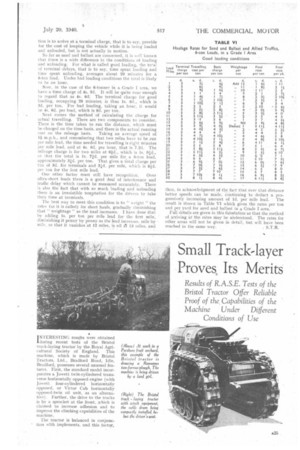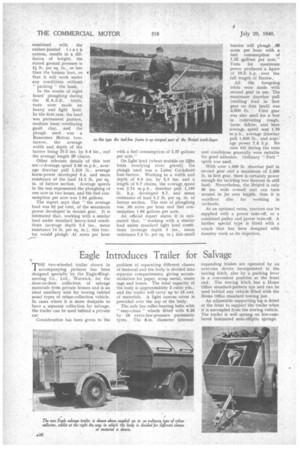Small Track-layer Proves Its Merits
Page 35

Page 36

If you've noticed an error in this article please click here to report it so we can fix it.
Results of R.A.S.E. Tests of the Bristol Tractor Offer Reliable Proof of the Capabilities of the Machine Under Different
Conditions of Use
I NTERESTING results were obtained during recent tests of the Bristol track-laying tractor by the Royal Agricultural Society of England. This machine, which is made by Bristol Tractors, Ltd., Bradford Road, Idle, Bradford, possesses several unusual features. First, the standard model incorporates a Jowett twin-cylindered transverse horizontally opposed engine (with jowett four-cylindered horizontally opposed, or Victor Cub horizontally opposed-twin oil unit, as an alternative). Further, the drive to the tracks is by a sprocket at the front, _which is claimed to increase adhesion and to improve the climbing capabilities of the machine.
The tractor is balanced in conjunction with implements, and this factor.
combined with the rubber-jointed track system, results in a diffusion of Weight; the stated ground pressure is 9i lb. per sq. in,, or less than the human foot, so4 that it will work under any conditions without " packing " the land In the course of eight hours' ploughing during the R.A.S.E. trials, tests were made on heavy and light land. In the first case, the land was permanent pasture, medium loam overlaying gault clay, and the plough used was a Ransomes Motrac twofurrow, the average width and depth of the furrow being 10.5 ins. by 4.4 ins., and the average length 20 chains.
Other relevant details of this test are:Average speed 2.69 m.p.h., aver age drawbar pull 1,310 lb., average horse-power developed 9.4, and mean resistance of the land 14.2 lb. per sq.
in. of furrow section. Average speeds in the test represented the ploughing of one acre in two hours, and the fuel consumption per acre was 1.94 gallons.
The report says that " the average load was 92 per cent, of the maximum power developed in second gear. It is estimated that, working with a similar load under standard heavy-land condi tions (average depth 5.5 ins., mean tesistance '14 lb. per sq. in.), this tractor would plough .41 acres per hour with a fuel consumption of 2.37 gallons per acre."
On light land (wheat stubble on light loam overlying river gravel) the plough used was a Lister Cockshutt four-furrow. Working to a width and depth of 9.8 ins. by 5.8 ins, and a length of 9.7 chains, the average speed was 2.74 m.p.h., drawbar pull 1.190 lb. h.p. developed 8,7. and mean resistance of land 5.2 lb. per sq. in. of furrow section. The rate of ploughing was .86 acres per hour and fuel consumption 1.06 gallons per acre.
An official report states it . is estimated that, " working with a similar load under standard light land conditions (average depth 5 ins., mean resistance 7.5 lb. per sq. in.) this small
tractor will plough .09 acres per hour with a fuel consumption of 1.32 gallons per acre." Tests for maximum power produced a figure of 10.2 h.p. over the full length of furrow.
All the foregoing trials were made with second geat in use. The maximum drawbar pull (stalling load in first gear on firm land) was 2,500 lb. First gear was also used for a test in cultivating rough, loose fallow, and here average, speed was 1.79 m.p.h., average drawbar pull 1,630 lb., and aver: age power 7.8 h.p. No rain fell during the tests and conditions generally were suitable for good adhesion. Ordinary `!Poo' " spirit was used.
With over 1,600 lb. drawbar Pull in second gear and a maximum of 2,500 lb. in first gear, there is certainly power enough for tackling two furrows in stiff land. Nevertheless, the Bristol is only 36 ins, wide overall and can turn around in its own length; thus it is excellent also for working in orchards.
As an optional extra, tractors can be supplied with a power take-off, or a combined pulley and power take-off. A further special type is fitted with a winch that has been designed with forestry work as its objective.




























































